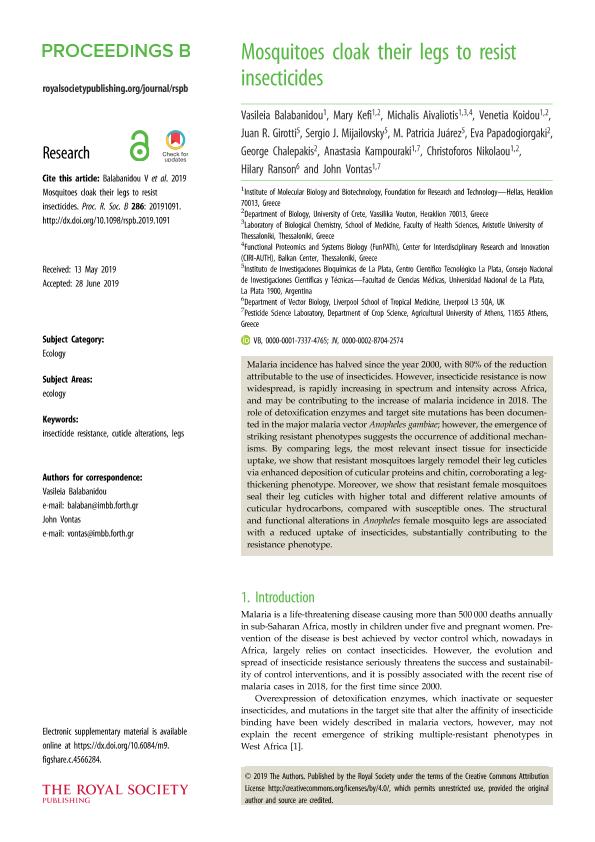Artículo
Mosquitoes cloak their legs to resist insecticides
Balabanidou, Vasileia; Kefi, Mary; Aivaliotis, Michalis; Koidou, Venetia; Girotti, Juan Roberto ; Mijailovsky, Sergio Javier
; Mijailovsky, Sergio Javier ; Patricia Juárez, M.; Papadogiorgaki, Eva; Chalepakis, George; Kampouraki, Anastasia; Nikolaou, Christoforos; Ranson, Hilary; Vontas, John
; Patricia Juárez, M.; Papadogiorgaki, Eva; Chalepakis, George; Kampouraki, Anastasia; Nikolaou, Christoforos; Ranson, Hilary; Vontas, John
 ; Mijailovsky, Sergio Javier
; Mijailovsky, Sergio Javier ; Patricia Juárez, M.; Papadogiorgaki, Eva; Chalepakis, George; Kampouraki, Anastasia; Nikolaou, Christoforos; Ranson, Hilary; Vontas, John
; Patricia Juárez, M.; Papadogiorgaki, Eva; Chalepakis, George; Kampouraki, Anastasia; Nikolaou, Christoforos; Ranson, Hilary; Vontas, John
Fecha de publicación:
17/07/2019
Editorial:
The Royal Society
Revista:
Proceedings of the Royal Society of London. Series B: Biological Sciences
ISSN:
0962-8452
Idioma:
Inglés
Tipo de recurso:
Artículo publicado
Clasificación temática:
Resumen
Malaria incidence has halved since the year 2000, with 80% of the reduction attributable to the use of insecticides. However, insecticide resistance is now widespread, is rapidly increasing in spectrum and intensity across Africa, and may be contributing to the increase of malaria incidence in 2018. The role of detoxification enzymes and target site mutations has been documented in the major malaria vector Anopheles gambiae; however, the emergence of striking resistant phenotypes suggests the occurrence of additional mechanisms. By comparing legs, the most relevant insect tissue for insecticide uptake, we show that resistant mosquitoes largely remodel their leg cuticles via enhanced deposition of cuticular proteins and chitin, corroborating a leg-thickening phenotype. Moreover, we show that resistant female mosquitoes seal their leg cuticles with higher total and different relative amounts of cuticular hydrocarbons, compared with susceptible ones. The structural and functional alterations in Anopheles female mosquito legs are associated with a reduced uptake of insecticides, substantially contributing to the resistance phenotype.
Palabras clave:
CUTICLE ALTERATIONS
,
INSECTICIDE RESISTANCE
,
LEGS
Archivos asociados
Licencia
Identificadores
Colecciones
Articulos(INIBIOLP)
Articulos de INST.DE INVEST.BIOQUIMICAS DE LA PLATA
Articulos de INST.DE INVEST.BIOQUIMICAS DE LA PLATA
Citación
Balabanidou, Vasileia; Kefi, Mary; Aivaliotis, Michalis; Koidou, Venetia; Girotti, Juan Roberto; et al.; Mosquitoes cloak their legs to resist insecticides; The Royal Society; Proceedings of the Royal Society of London. Series B: Biological Sciences; 286; 1091; 17-7-2019; 1-9
Compartir
Altmétricas



